
by Naomi Elbinger
When I was a kid growing up in Australia, I heard my great aunt say: “A trip is no fun unless you take along good food to eat.”
Now that I’m blessed to live and hike in this Holy Land, I think the best snacks are the ones provided by the trail itself.
The Land of Israel is rich in wild edible fruits, nuts, herbs and leaves. My eyes are always open for this seasonal bounty, and so often I find that feasting on the trailside is the highlight of any excursion, whether I’m trekking on a remote trail or just taking a stroll around my neighborhood!
I have compiled this list of favorite wild snacks, including where and when to find them, and how to identify them.
Disclaimer: This is an introductory article and not a comprehensive guide. Do not eat any plant that you cannot identify with accuracy.
Grapes – גפן:
Let’s start with an easy-to-identify one! I’ll assume you are familiar with what grape vines, leaves and fruits look like. So many of our hikes have been sweetened by a bunch of wild grapes.
Where: They grow wild along many a trail, often seen climbing up an old olive tree. They are common in old abandoned orchards and close to water sources. Ein Lavan, on the outskirts of Jerusalem, is a festival of wild grapes, and the Sataf has a few abandoned vineyards that are loaded in season.

When: Native grapes usually ripen in July-August, but if you find them in September-October, that’s the perfect time to enjoy sun-dried raisins!
Tip: I’m willing to bet there are people in your neighborhood with thriving grape vines who don’t pick them. Make friends with them. This is also foraging!
Carob- חרוב:
The distinctive Carob pods are usually processed into syrup and powder before eating, but they can also make a great trailside snack. Break the pods in half – if they’re the good kind, a honey-like syrup will ooze out, which you can suck. Many kids love climbing carob trees to pick the juiciest pods. Childhood memories are made of tree climbing and honey-licking!
Where: Common all over Israel, especially in JNF picnic areas and abandoned orchards, as well as in city parks.
When: Carob season is September-December. Later in the winter they will be less juicy, but still worth a try.
Tip: Pick shiny fat brown pods off the tree. The ones that have fallen to the ground are not as good.
Almonds – שקדים
Israel is famous for its almond trees decked in showy fragrant pinky-white blossoms in late winter. Many of us will go on a hike just to see their magnificent-if-fleeting display. The nuts ripen in the late summer and if you’ve ever tried to eat one, you probably discovered that they taste beyond awful (and in quantity are poisonous – but who could eat more than one bite anyhow?) The secret with almond trees is that there are two kinds: bitter and sweet. The bitter ones are more common and have more beautiful blossoms. So keep your eyes open for trees that are less showy – smaller flowers mixed with green leaves.

Where: All over Israel – in both city and nature spots
When: September-October.
Tips: When you meet an almond tree at this time, pick and nut and taste a tiny sample. You will sometimes get lucky and be able to add nourishing, delicious almonds to your trail mix!
Katlav
This is a native fruit that you may not have heard of, but trust me, it’s a real trail-side treat. The beautiful Katlav trees, with their distinctive red bark and graceful smooth trunks, are worth admiring at any time of year, but they are extra special in fruiting season. The fruits are round and the size of grapes. The taste is sweet and sour, and in my opinion, one of the yummiest wild snacks around.

Where: Most common around Jerusalem. The trails around Nachal Katlav are especially full of them. You can also spot them growing by the roads and highways around there. Look for the red bark.
When: September-December.
Tips: The fruits start off green, then turn yellow, then darken to orange. They should be juicy and dark. The darker they are, the sweeter they taste. Lighter ones are extremely sour.
Ashchar אשחר
This is a small unassuming thorny tree with little leaves that you’ve probably hiked past a hundred times and never paid any notice. But in late summer it is full of the most delicious and refreshing currents. They are perfectly round and the size of lentil. It is recommended to spit out the seeds, as eating too many has a laxative effect.
Where: All over Israel.
When: August-September.
Tip: The currents get a purplish tint when ripe but have distinctive black streaks on the skin. If there are no streaks – don’t eat it!
Wild Asparagus אספרגוס
Asparagus is a real delicacy here in Israel. You hardly see it in the supermarkets and when it appears, the price is high. The good news is you can see and enjoy wild asparagus many months of the year when out hiking. It’s only the new shoots we eat, before it unfurls its spiky leaves.
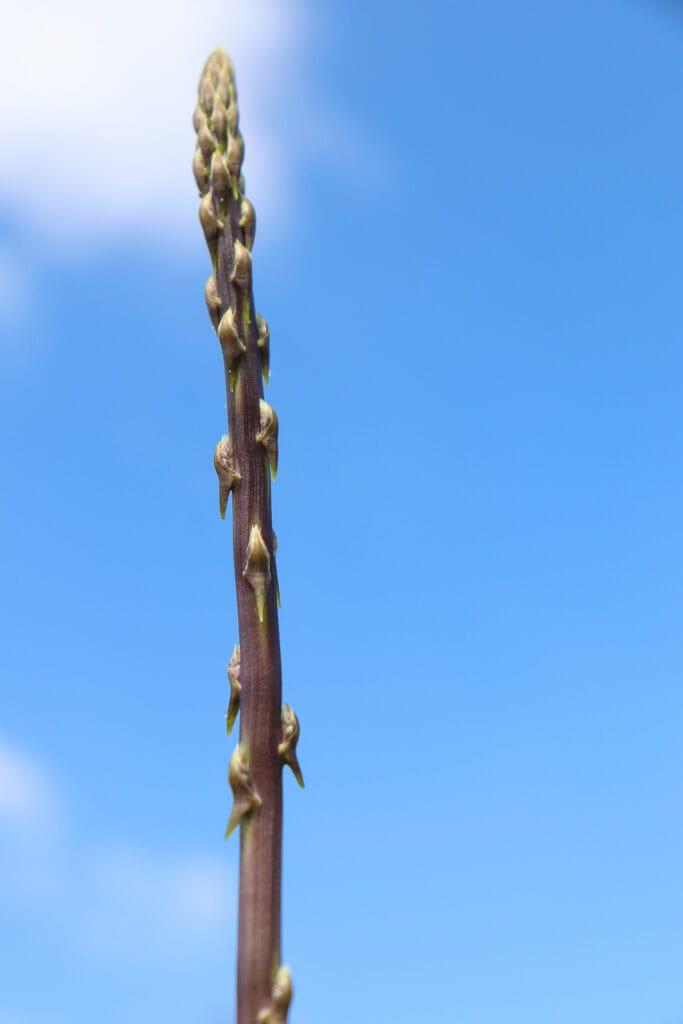
Where: Plentiful in the mountainous areas around Israel. It is usually found in the shade of a native tree, such as an oak or olive.
When: October-April, with a peak in mid-winter.
Tips: The distinctive spindly leaves are easy to find. Then take a closer look at the base of the plant, until you spot some fresh shoots just emerging from the ground. They look like commercially grown asparagus, only thinner.
Wild Fennel שומר
My kids call this the “Black Jellybean Plant” because that’s exactly what the unripened seeds taste like. If you enjoy anise flavor, these are a treat. I rarely go on a hike without munching on some of these.
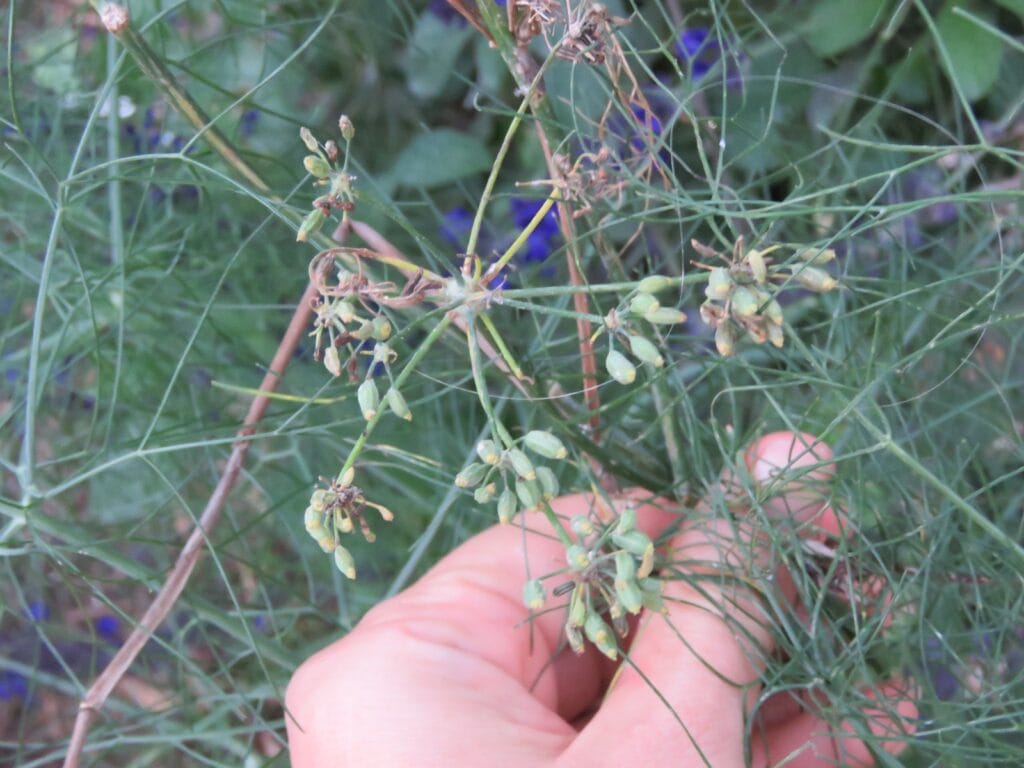
Where: All over Israel’s hillsides in open areas (not in forests)
When: You can pick these all year, but they’re at their peak from January-May
Tip: The leaves of a fennel plant look exactly like dill but the plant is much bigger than dill. Break and smell the leaves first before eating – you will easily identify the plant by the anise smell. The unripe seeds are green and succulent – that’s when they’re best for snacking on.
Blackberries פטל קדוש
The local wild variety of blackberries are a bit different from what you remember from the US or Europe. But the plant resembles the familiar characteristics of brambles – the impenetrable thorny canes and the green bunch-like berries that ripen to dark-red-purple.

Where: They are not so common but I’ve seen them in surprising places around the Judean Hills. The other day, I saw them growing in the picnic areas in the Emek Ha’Arazim park in Jerusalem, we’re they were obviously planted by the park planners.
When: They are at their peak in July-July but you can get lucky most of the year
Tip: Blackberries can be bug infested. Proceed with caution.

Naomi Elbinger AKA Bloomah is developing her own productive urban farm in the backyard of her apartment in the rapidly growing city of Beit Shemesh. You can get more tips from Naomi about foraged and homegrown food on the Bloomah’s City Farm blog or on Facebook
Want to know learn which plant you collect on the trail to use as a natural fertilizer? What you need to make your own raised beds on the cheap? How to start your own butterfly farm? Check out Naomi’s amazing blog!


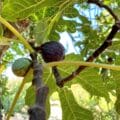


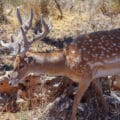
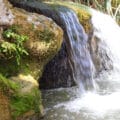
In a field near us (Ramat Gan), there is a group of “trees” that look like asparagus. They are very fast-growing, and look like the photo above. Are you saying that edible asparagus are growing with them?
Also confused about the fennel. At Park Ariel Sharon, we found lots of wild fennel plants, but there didn’t seem to be anything edible about them. There were no roots akin to the shumar you buy in the store.
Thanks!
This is Naomi – author of the article.
1. Asparagus: These are small and barely a bush. No one would call them a tree. So you’re probably not seeing asparagus. I haven’t seen a pic of the plant in question but I’ll take a wild guess that it’s an agave plant, which looks kind of like a big aloe at the bottom and then sends up a ridiculously huge flower stem that is as big as a tree. Agave is from the asparagus family and before the flower opens, it looks like a mammoth asparagus stem. Don’t try sink your teeth into it! Though if you’re the wildcrafting type (like me) you’d probably be googling “how to make agave nectar from plant” right now. More about agave here: https://en.wikipedia.org/wiki/Agave
2. Fennel: the cultivated type that you buy in the store is picked young, before it sends up its flower stem. Once it goes to flower, the the bulb get too tough to be yummy. In general, the wild variety are more tough. In my article I suggest eating the unripe seeds. You will soon see them on the plants near you, after the yellow flowers begin to fade, probably by late January/February.